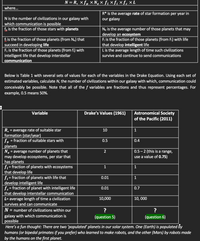
Applications and Investigations in Earth Science (9th Edition)
9th Edition
ISBN: 9780134746241
Author: Edward J. Tarbuck, Frederick K. Lutgens, Dennis G. Tasa
Publisher: PEARSON
expand_more
expand_more
format_list_bulleted
Question
can i get help with the questions attached below questions 5 and 6.

Transcribed Image Text:N = R, × f, × N, × f, ×f; ׃. x L
where...
R* is the average rate of star formation per year in
our galaxy
N is the number of civilizations in our galaxy with
which communication is possible
f, is the fraction of those stars with planets
f is the fraction of those planets (from Ne) that
succeed in developing life
Fe is the fraction of those planets (from f;) with
intelligent life that develop interstellar
communication
Ne is the average number of those planets that may
develop an ecosystem
F, is the fraction of those planets (from Fi) with life
that develop intelligent life
Lis the average length of time such civilizations
survive and continue to send communications
Below is Table 1 with several sets of values for each of the variables in the Drake Equation. Using each set of
estimated variables, calculate N, the number of civilizations within our galaxy with which, communication could
conceivably be possible. Note that all of the f variables are fractions and thus represent percentages. For
example, 0.5 means 50%.
Variable
Drake's Values (1961)
Astronomical Society
of the Pacific (2011)
R, = average rate of suitable star
formation (star/year)
10
1
= fraction of suitable stars with
0.5
0.4
planets
Ne = average number of planets that
may develop ecosystems, per star that
has planets
fi = fraction of planets with ecosystems
that develop life
fi = fraction of planets with life that
develop intelligent life
f.= fraction of planet with intelligent life
that develop interstellar communication
L= average length of time a civilization
0.5- 2 (this is a range,
use a value of 0.75)
2
1
0.01
1
%3D
0.01
0.7
%3D
10,000
10, 000
survives and can communicate
N = number of civilizations within our
?
?
galaxy with which communi
possible
Here's a fun thought: There are two 'populateď planets in our solar system. One (Earth) is populated by
ion is
(question 5)
(question 6)
humans (or bipedal primates if you prefer) who learned to make robots, and the other (Mars) by robots made
by the humans on the first planet.
Expert Solution
This question has been solved!
Explore an expertly crafted, step-by-step solution for a thorough understanding of key concepts.
This is a popular solution
Trending nowThis is a popular solution!
Step by stepSolved in 2 steps

Knowledge Booster
Recommended textbooks for you
 Applications and Investigations in Earth Science ...Earth ScienceISBN:9780134746241Author:Edward J. Tarbuck, Frederick K. Lutgens, Dennis G. TasaPublisher:PEARSON
Applications and Investigations in Earth Science ...Earth ScienceISBN:9780134746241Author:Edward J. Tarbuck, Frederick K. Lutgens, Dennis G. TasaPublisher:PEARSON Exercises for Weather & Climate (9th Edition)Earth ScienceISBN:9780134041360Author:Greg CarbonePublisher:PEARSON
Exercises for Weather & Climate (9th Edition)Earth ScienceISBN:9780134041360Author:Greg CarbonePublisher:PEARSON Environmental ScienceEarth ScienceISBN:9781260153125Author:William P Cunningham Prof., Mary Ann Cunningham ProfessorPublisher:McGraw-Hill Education
Environmental ScienceEarth ScienceISBN:9781260153125Author:William P Cunningham Prof., Mary Ann Cunningham ProfessorPublisher:McGraw-Hill Education Earth Science (15th Edition)Earth ScienceISBN:9780134543536Author:Edward J. Tarbuck, Frederick K. Lutgens, Dennis G. TasaPublisher:PEARSON
Earth Science (15th Edition)Earth ScienceISBN:9780134543536Author:Edward J. Tarbuck, Frederick K. Lutgens, Dennis G. TasaPublisher:PEARSON Environmental Science (MindTap Course List)Earth ScienceISBN:9781337569613Author:G. Tyler Miller, Scott SpoolmanPublisher:Cengage Learning
Environmental Science (MindTap Course List)Earth ScienceISBN:9781337569613Author:G. Tyler Miller, Scott SpoolmanPublisher:Cengage Learning Physical GeologyEarth ScienceISBN:9781259916823Author:Plummer, Charles C., CARLSON, Diane H., Hammersley, LisaPublisher:Mcgraw-hill Education,
Physical GeologyEarth ScienceISBN:9781259916823Author:Plummer, Charles C., CARLSON, Diane H., Hammersley, LisaPublisher:Mcgraw-hill Education,

Applications and Investigations in Earth Science ...
Earth Science
ISBN:9780134746241
Author:Edward J. Tarbuck, Frederick K. Lutgens, Dennis G. Tasa
Publisher:PEARSON

Exercises for Weather & Climate (9th Edition)
Earth Science
ISBN:9780134041360
Author:Greg Carbone
Publisher:PEARSON

Environmental Science
Earth Science
ISBN:9781260153125
Author:William P Cunningham Prof., Mary Ann Cunningham Professor
Publisher:McGraw-Hill Education

Earth Science (15th Edition)
Earth Science
ISBN:9780134543536
Author:Edward J. Tarbuck, Frederick K. Lutgens, Dennis G. Tasa
Publisher:PEARSON

Environmental Science (MindTap Course List)
Earth Science
ISBN:9781337569613
Author:G. Tyler Miller, Scott Spoolman
Publisher:Cengage Learning

Physical Geology
Earth Science
ISBN:9781259916823
Author:Plummer, Charles C., CARLSON, Diane H., Hammersley, Lisa
Publisher:Mcgraw-hill Education,